You can take an entire college course and never be told that pH stands for potential of Hydrogen atoms
Note: This investigation is a work in progress. Check back soon for more updates!
or in simpler terms:
ELECTRICITY THROUGHOUT THE BODY.
Healthy Cells = -30mV. Cancer = +30mV.
Healing is Voltage
"Cells are designed to run between a pH of 7.35 and 7.45.
"We doctors are trained to pay particular attention to things that are abnormally high. For example we watch carefully for high blood sugar (diabetes), however, we rarely think about hypoglycemia unless a patient is dizzy or faint. We watch carefully for a high temperature including fever, but we are not trained that a low temperature indicated hypothyroidism. We watch carefully for high blood pressure and are insensitive to the fact that low blood pressure due to over-exuberant prescription of medications is causing our patients to be dizzy. We rarely look at pH levels or oxygen levels unless the patient is in intensive care.
"I want to focus on the importance of pH. When I was trying to figure out how to get well, I couldn’t remember a lot about pH. I remembered that it was something about acid/base balance but I knew very little more than that. So I began to read about pH. What I discovered is that pH (shorthand for potential hydrogen) is really the measurement of voltage. (see article #1)
"When electrons are running through a conductor like a copper wire, they are there or not. If the switch is on, you have an electron donor. If the switch is off, there are no electrons.
"However, a solution provides a different situation. The solution may be an electron donor or an electron stealer. One measures the voltage of a solution with a sophisticated voltmeter. By convention, if the solution is an electron donor, one puts a minus (-) sign in front of the voltage. If, however, the solution is an electron stealer, one put a plus (+) in front of the voltage. For example, if your pH voltmeter measures +150 millivolts, that means the solution is an electron stealer with 150 millivolts of stealing power. If your pH voltmeter measures -200 millivolts, it means that the solution is an electron donor with 200 millivolts of donating power.
"After measuring the voltage of a solution, one can convert that into a logarithmic scale called pH. A voltage of +400 mV is the same as a pH of zero. A voltage of -400 mV is the same as a pH of 14. A solution that is neither an electron donor nor an electron stealer is called a pH of seven.
pH scale vs. voltage
"With this understanding, one can see that a pH of 7.35 is the same as a voltage of -20 mV. A pH of 7.45 is the same as a voltage of -25 mV. Thus we see that all cellular biology texts tell us that cells are designed to run between -20 and -25 millivolts of electron donor status!
Electron stealers cause damage, are a pH of 0 to 6.9, are acidic, are free radicals, are the positive pole, are destructive and at the atomic level spin left.
You will hear statements like "all disease occurs when you are acidic”. What this is really saying is that all disease occurs when your voltage is low or in an electron stealer state. The phrase “alkalize or die” means is that you must have electrons available to do work or your cells will die.
A free radical is a molecule that is missing electrons. It is like a mugger looking for someone’s purse to steal. When a free radical steals electrons from the cell, it damages the cell.
An antioxidant is a molecule capable of giving away electrons. Thus, when your mother says “ eat your vegetables “ she is saying that the vegetables contain electrons that are good for you.
We maintain our health and heal primarily by making new cells. To make new cells requires a voltage of -50 mV
Salivary and urinary pH are about 0.8 pH units less than cell pH. Salivary pH is a rough indicator of cellular voltage. Urinary pH is a rough indicator of the voltage I the fluids around cells. When normal, both should be 6.5. If you add 0.8 to 6.5 you get a pH of 7.3. This equates to -20 millivolts. Now let’s consider my thumb. My thumb is running at a voltage of -25 mV. It is pink, feels fine and works well. Now I hit it with a hammer. The thumb turns red, swollen, is hot and has a pulsing pain. It has automatically gone to -50 mV. This is necessary to make new cells needed to replace the ones I damaged with a hammer. At -50 mV, blood vessels dilate and dump raw materials such as proteins, carbohydrates, fats vitamins, minerals, etc. into the neighborhood. I need these raw materials to build new cells. I also need -50 mV to have the energy to turn these raw materials into new cells.
As soon as I finish making enough cells to replace those I damaged with the hammer, my thumb goes back to -25 mV. It is normal and I am happy.
Now let’s assume that I ran out of voltage before I was able to make enough new cells to replace those that I injured with a hammer. My voltage dropped to -10 mV. Now I am stuck in chronic disease. I cannot heal unless I can make new cells. I cannot make new cells unless I have -50 mV and all the raw materials I need to make new cells. In chronic disease, my thumb huts all the time, it is white and doesn’t work very well.
Thus we see that chronic disease is always defined as having low voltage. One cannot cure chronic disease without inserting enough electrons to achieve -50 mV. One must also have the raw materials necessary to make new cells and to eliminate the toxins or infections present that will damage the new cells. One can take all the medications you like and do as much surgery as you like, but you will not heal unless you have -50 mV, raw materials and lack of toxins.
Without the ability to achieve -50 mV and the necessary raw materials to make new cells, you cannot maintain your health and you suffer aging and chronic disease. You are also unable to repair injuries that can also lead to chronic disease. You don’t need drugs to heal. You need to make new cells that work to heal. To make good cells you need voltage and a good diet. You also need to remove toxins from your body that damage cells and make you obese.
Once one begins to understand that chronic disease and healing are controlled by voltage, one must ask the following questions:
- How do cells normally get voltage?
- How do cells store voltage?
- Why did my voltage drop to allow me to get sick?
- How do I measure voltage of organs?
- What do I do when I find the voltage is low?
a.md
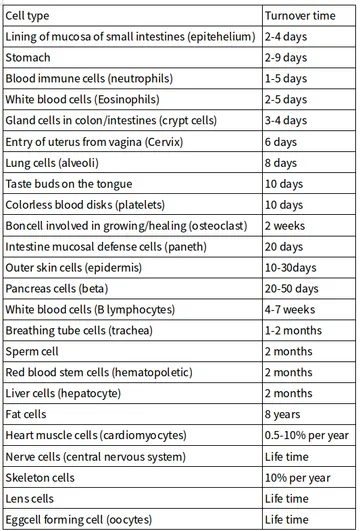
cell-regen.png

cloning.jpg
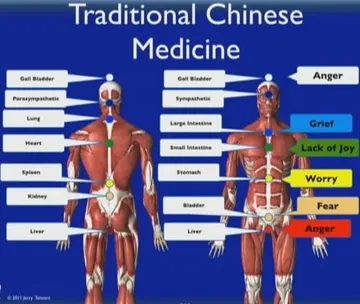
eastern_medicine.jpg
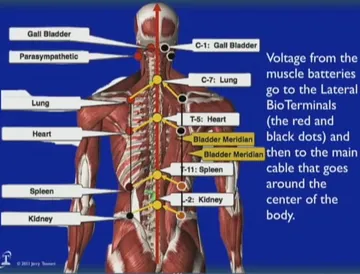
eastern_medicine2.jpg
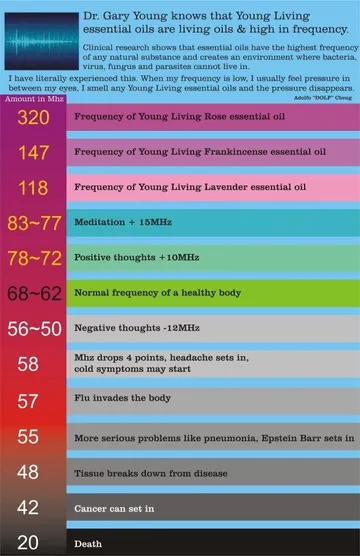
frequency_health.jpg
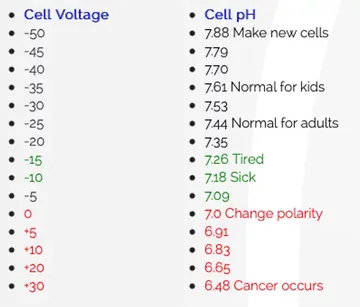
frequency_health2.jpg
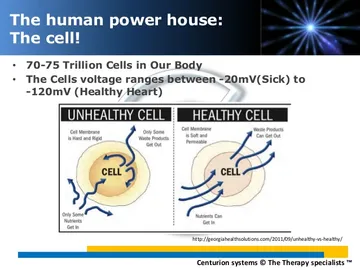
ph_healthy_cell.jpg
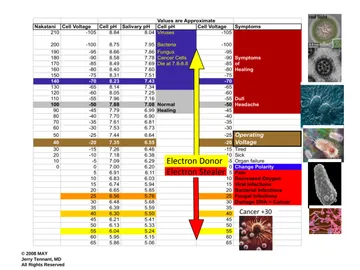
ph_scale1.jpg
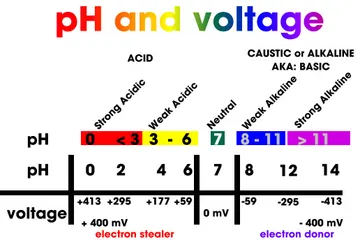
ph_scale2.jpg

ph_scale3.jpg
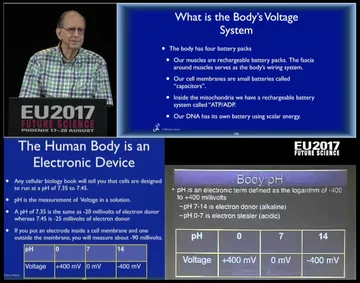
ph_voltage.jpg

ph_voltage2.jpg
Biological ConflictConflict-Active Phase**Healing Phase **
DEVELOPMENT AND FUNCTION OF THE BRONCHIAL MUCOSA: The bronchial tubes branch from the trachea into two main bronchi from where they subdivide inside each lung into numerous small ducts, called bronchioles. The main function of the bronchi and bronchioles is to carry air into the lung alveoli, where oxygen and carbon dioxide are exchanged during respiration. The bronchial mucosa consists of squamous epithelium, originates from the ectoderm and is therefore controlled from the cerebral cortex.
BRAIN LEVEL: The bronchial mucosa of both lungs is controlled from the right temporal lobe (part of the * *sensory cortex)**. The control center is positioned exactly across from the brain relay of the laryngeal mucosa.
BIOLOGICAL CONFLICT: The biological conflict linked to the bronchial mucosa is a male territorial fear conflict or female **scare-fright conflict **, depending on a person’s gender, laterality, and hormone status (see also Flying Constellation). The male territorial fear conflict is the equivalent to the female nest-worry conflict. In fact, originally, Dr. Hamer termed the bronchi-related DHS a “territorial-worry conflict”.
Gender, Laterality, Hormone Status
Biological Conflict
Affected Organ
Right-handed male ([NHS]( "::Normal hormone status"))
Territorial fear conflict
Bronchial mucosa
Left-handed male ([NHS]( "::Normal hormone status"))
Territorial fear conflict
Right-handed male ([LTS]( "::Low testosterone status"))
Left-handed male ([LTS]( "::Low testosterone status"))
Bronchial mucosa*
Right-handed female ([NHS]( "::Normal hormone status"))
Left-handed female ([NHS]( "::Normal hormone status"))
Bronchial mucosa*
Right-handed female [(LES)]( "::Low estrogen status")
Territorial fear conflict
Bronchial mucosa
Left-handed female [(LES)]( "::Low estrogen status")
Territorial fear conflict
NHS = Normal hormone status LTS = Low testosterone status LES = Low estrogen status
*With left-handers the conflict is transferred to the other brain hemisphere
In line with evolutionary reasoning, territorial conflicts, sexual conflicts, and separation conflicts are the primary conflict themes associated with organs of ectodermal origin, controlled from the [sensory, pre-motor sensory and post-sensory cortex]( "::").
A territorial fear conflict refers to a threat to the “territory”, a fear within the “territory” (at home, at work, at school, at the playground, in kindergarten or daycare, in a seniors home, in the hospital, or in the village, city, and country where one lives), and to a fear regarding one’s own safety as well as the safety of the “pack”. Physical abuse, family violence, mobbing, bullying, an accident, fire or flooding, an acute medical condition, a frightening diagnosis or prognosis, scary medical procedures, or hospitalization are a few examples of what can trigger the conflict. Children suffer the conflict when they are punished, abused, or yelled at, when they are terrified of a person or a situation, when they watch spooky films or videos showing monsters or vampires, or when they have nightmares. An adult’s panic can also create a territorial fear in a child! Unborn children experience the conflict in the womb when the mother is in danger or at birth during a difficult delivery. The conflict could also concern a member of the “territory” (a fear of losing a partner who secures a home or when a loved one is seriously ill, hospitalized, or diagnosed with cancer – associated with a “fatal disease”). A territorial fear can be shared by people of large regions, for example, during a natural disaster, during wartimes, or through scares of terrorist attacks or pandemic fear-mongering (AIDS, SARS, Swine Flu, and the like) by the media.
The Biological Special Program of the bronchial mucosa follows the OUTER SKIN SENSITIVITY PATTERN with hyposensitivity during the conflict-active phase and the Epileptoid Crisis and hypersensitivity in the healing phase.
CONFLICT-ACTIVE PHASE: [ulceration in the bronchial mucosa]( "::") proportional to the degree and duration of conflict activity. The biological purpose of the cell loss is to widen the respiratory passageways so that more air can reach the lungs. The enhanced function of the lungs serves to facilitate a conflict resolution. There are no symptoms in the conflict-active phase.
This brain CT shows the impact of a territorial fear conflict in the area of the cerebral cortex that controls the bronchial mucosa (view the GNM diagram). The sharp border of the Hamer Focus reveals conflict activity.
HEALING PHASE: During the first part of the healing phase ([PCL-A]( "::")) the tissue loss is replenished through cell proliferation. Healing symptoms are pain due to the swelling caused by the edema (fluid accumulation), **tickles in the lungs ** (itching or pruritus is characteristic for any healing involving squamous epithelial tissue such as the skin) and coughing. Coughing facilitates bringing up phlegm containing remnants of the repair process. Depending on the intensity of the conflict, the symptoms range from mild to severe. After the Epileptoid Crisis, in [PCL-B]( "::"), the swelling recedes and the function of the bronchi returns to normal.
In conventional medicine, the cell proliferation that takes place in [PCL-A]( "::") is diagnosed as a “lung cancer” or **bronchial cancer ** (compare with lung cancer related to the lung alveoli). Based on the Five Biological Laws, the new cells cannot be regarded as “cancer cells” since the cell increase is, in reality, a replenishing process.
The swelling in a bronchial tube can block the air passages resulting in a bronchial atelectasis. On a lung X-ray, the lung, void of air due to the obstruction, appears as white (see picture). After the Epileptoid Crisis, the bronchial tube reopens accompanied by heavy coughs and sputum production. However, with a hanging healing, when the repair process is continually interrupted by conflict relapses, the scar-buildup eventually hardens with the result that the atelectasis remains (this is also referred to as COPD-Chronic Obstructive Pulmonary Disease). The bronchial constriction causes permanent breathing difficulties, even after the healing phase has been completed.
According to Dr. Hamer, an atelectasis is often misdiagnosed as a bronchial tumor.
Bronchitis occurs when healing is accompanied by an inflammation, typically with fever, headaches because of the swelling in the corresponding brain relay, and fatigue since the autonomic nervous system is in a state of prolonged rest (vagotonia). In conventional medicine, recurring bronchitis is generally associated with “allergies” (see also bronchial asthma).
Pneumonia is bronchitis with the SYNDROME, that is, with water retention as a result of an active abandonment or existence conflict involving the kidney collecting tubules. In [PCL-A]( "::"), the retained water is exceedingly stored in the bronchial tubes ( compare with lung edema). On the brain level, the excess water could lead to serious complications, particularly during the Epileptoid Crisis, which is the critical point (“pneumonic lysis”) when the brain edema is expelled. The brain pressure caused by the sympathicotonic surge could be so strong that the person falls into a coma and dies. However, if the conflict-active phase lasted less than 4-5 months, the Epi-Crisis is, according to Dr. Hamer, not life-threatening.
NOTE: All Epileptoid Crises that are controlled from the [sensory, post-sensory, or pre-motor sensory cortex]( "::") []( "::") are accompanied by troubled circulation, dizzy spells, short disturbances of consciousness or a complete * loss of consciousness* (fainting or “absence”), depending on the intensity of the conflict. Another distinctive symptom is a drop of blood sugar caused by the excessive use of glucose by the brain cells (compare with hypoglycemia related to the islet cells of the pancreas).
So-called Legionnaires’ disease is a type of pneumonia. The name originates from an outbreak of pneumonia among people who had attended a convention of the American Legion in Philadelphia in 1976. What was possibly the territorial fear conflict experienced by so many participants of the meeting?
“Bacterial pneumonia” indicates that the repair and scarring process ([PCL-B]( "::")) is assisted by bacteria. This is usually the case when the ulceration that takes place in the conflict-active phase reaches deep into the bronchial tissue.
Conventional medicine claims that “viral pneumonia” is caused by viruses, notably by influenza viruses that purportedly caused the * Spanish Flu pandemic* after the First World War or, in our days, SARS, the Bird Flu, the Swine Flu, and the like. However, none of the [influenza viruses]( "::") have ever been scientifically verified (details are presented in the “Virus Mania” GNM video). [Threats of a global “influenza pandemic]( "::")”, however, can trigger territorial fear and existence conflicts among the population resulting in a fast increase of * influenza* cases.
These statistics of the Spanish Flu pandemic show that the outbreak started at the beginning of October 1918 reaching its height 3-4 weeks later. According to historical records, Germany asked the Allies for a ceasefire on October 4th, 1918 (the official date of the end of the First World War is November 11, 1918).
With the prospect of peace, millions of people worldwide went into healing of territorial fear conflicts they had suffered during four years of war (see also lung tuberculosis epidemic of 1918/19).
Source: National Museum of Health and Medicine, Armed Forces Institute of Pathology, 2006 22
Pneumonia is also the most common lung condition associated with [HIV]( "::") and AIDS. As we now come to understand, there is no causal relation at all to the alleged HI-Virus []( "::"If there is evidence that HIV causes AIDS, there should be scientific documents which either singly or collectively demonstrate that fact, at least with a high probability. There is no such document."- Dr. Kary Mullis, Nobel Prize Laureate for Chemistry 1993")but rather to a “territorial fear” or scare-fright conflict associated with the “disease”.
AIDS-Acquired Immune Deficiency Syndrome
“If there is evidence that HIV causes AIDS, there should be scientific documents which either singly or collectively demonstrate that fact, at least with a high probability. There is no such document” (Dr. Kary Mullis, Nobel Prize Laureate for Chemistry 1993).
“Up to today, there is no single scientifically convincing evidence for the existence of HIV. Not even one such retrovirus has been isolated and purified by the methods of classical virology” (Dr. Heinz Ludwig Sanger, Emeritus Professor for Molecular Biology and Virology, Max Planck Institute for Biochemistry, Munich).
In 1983, the American researcher Robert Gallo claimed that he had discovered the “human immunodeficiency virus” (HIV) as the agent responsible for the cause of AIDS. In 1984, Gallo published four articles in Science, in which he stated that he had isolated the HIV virus. In December 2008, thirty-seven legal, medical and research professionals sent a letter to the journal, asking it to officially retract the original four papers that made the case for HIV as the cause of AIDS. According to the authors, widespread evidence had emerged that Gallo’s studies were not only poorly carried out, but that their results were falsified. The letter from the 37 experts includes a letter from Gallo himself, admitting to another researcher that HIV could not be isolated from human samples alone. In addition, a letter from an electron microscopy expert revealed that there was no HIV virus contained in Gallo's 1984 samples.
Dr. Hamer: “The ‘AIDS’ symptoms are the result of the invention of AIDS.”
Based on the understanding of the Five Biological Laws, most of the “AIDS” symptoms are caused by the diagnosis shock and of biological conflicts triggered by the fear of the disease. Here are a few examples:
-
death-fright conflict involving the lungs (lung tuberculosis, lung emphysema)
-
scare-fright conflicts resulting in respiratory symptoms such as bronchitis or pneumonia
-
self-devaluation conflicts (anemia, leukemia, bone cancer, lymphoma)
attack or “feeling soiled” conflicts (shingles, Kaposi sarcoma)
-
bleeding conflicts triggered by blood tests leading to an enlarged spleen
NOTE: Usually, a rise in antibodies is considered a sign of a “strong immune system”. But not when it comes to AIDS. In HIV tests, the presence of antibodies is considered an indication that the person is “seropositive”, in other words, “infected” with the “Human Immuno Deficiency Virus”!
BRONCHIAL MUCOSA
Case Studies - Dr. Alvin De Leon
virus.md






